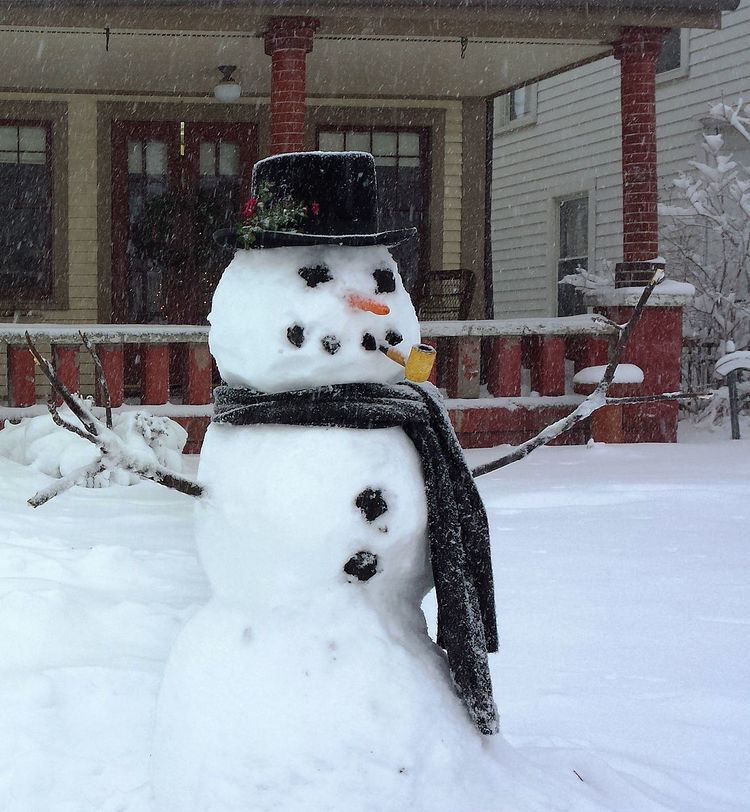 | ||
A snowman is an anthropomorphic snow sculpture often built by children in regions with sufficient snowfall. In many places, typical snowmen consist of three large snowballs of different sizes with some additional accoutrements for facial and other features. Due to the sculpt-ability of snow, there is also a wide variety of other styles. Common accessories include branches for arms and a rudimentary smiley face, with a carrot standing in for a nose. Human clothing, such as a hat or scarf, may be included. Low-cost and availability are the common issues, since snowmen are usually abandoned to the elements once completed.
Contents
Construction
Snow becomes suitable for packing when it approaches its melting point and becomes moist and compact. Making a snowman of powdered snow is difficult since it will not stick to itself, and if the temperature of packing snow drops, it will form an unusable denser form of powdered snow called crust. Thus, a good time to build a snowman may be the next warm afternoon directly following a snowfall with a sufficient amount of snow. Using more compact snow allows for the construction of a large snowball by simply rolling it until it grows to the desired size. If the snowball reaches the bottom of the grass it may pick up traces of grass, gravel or dirt.
In Europe and North America, snowmen are built with three spheres depicting the head, torso, and lower body. The usual practice is to then decorate and optionally dress the snowman. Sticks can be used for arms, and a face is traditionally made with stones or coal for eyes and a carrot for a nose. Some like to dress their snowmen in clothing such as a scarf or hat, while others prefer not to risk leaving supplies out doors where they could easily be stolen or become stuck under melting ice.
There are variations to these standard forms; for instance, the popular song "Frosty the Snowman" describes a snowman being decorated with a corncob pipe, button nose, coal eyes and an old silk hat (usually depicted as a top hat). These other types range from snow columns to elaborate snow sculptures similar to ice sculptures.
One book describes classic snowman attachments as a black felt top hat, red scarf, coal eye pieces, carrot nose, and corn cob pipe.
History
Documentation of the first snowman is unclear. However, Bob Eckstein, author of The History of the Snowman documented snowmen from medieval times, by researching artistic depictions in European museums, art galleries, and libraries. The earliest documentation he found was a marginal illustration from a work titled Book of Hours from 1380, found in Koninklijke Bibliotheek, in The Hague. The earliest known photograph of a snowman was taken in 1853 by Welsh photographer Mary Dillwyn, the original of which is in the collections of the National Library of Wales.
In media
Snowmen are a popular theme for Christmas and winter decorations and also in children's media. A famous snowman character is Frosty, the titular snowman in the popular children's song "Frosty the Snowman" (later adapted into film and television specials), who was magically brought to life by the old silk hat used on his head. In addition to numerous related music and other media for Frosty, snow-men also feature as:
Giant snowmen and records
In 2015, a man from the U.S. State of Wisconsin was noted for making a large snowman 22 feet tall and with a base 12 feet wide.
The record for the world's largest snowman was set in 2008 in Bethel, Maine. The snow-woman stood 122 feet 1 inch (37.21 m) in height, and was named in honor of Olympia Snowe, a U.S. Senator representing the state of Maine.
The previous record was also a snowman built in Bethel, Maine, in February 1999. The snowman was named "Angus, King of the Mountain" in honor of the then current governor of Maine, Angus King. It was 113 feet 7 inches (34.62 m) tall and weighed over 9,000,000 pounds (4,080,000 kg).
A large snowman known as "Snowzilla" has been built each winter in Anchorage, Alaska.
In December 2016 the smallest snowman of sorts was created in a nano-fabrication facility at University of Western Ontario. It consisted of three roughly 0,9 micron spheres of silica, platinum arms and nose, and a face made by an ion beam.
In Unicode
In Unicode, the symbol for « snow man » is U+2603 (☃).
Also, « snowman without snow » is U+26C4 (⛄).
Snowman themed things
Snowmen can also be a theme for toys, costumes, and decorations.
One common time for Snowman themed decorations is during the winter holiday and Christmas season, where it is celebrated. One crafted book suggested a plan making a small Snowman doll out of white glove, ribbon, and other craft items.
One book on on snowmen, which included instrunctions on working with real snow, also mention edible snowmen themed foods. Some options for snowman themed food items include ice cream, marshmallows, and macaroons.
Variations
In addition to snowmen, there other things can produced with similar materials. Typical variations on the snowman concept include using raw-materials other then snow, or using similar materials but a new meme. See Snow sculpture.
